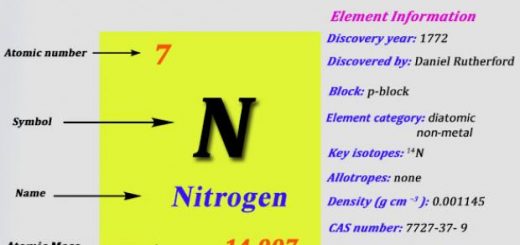Atomic structure of matter, Energy levels, Electronic distribution and chemical activity
Chemists use symbols to express elements easily, The symbol of any element is represented by its atom, The atom is the fundamental building unit of matter, It is the smallest individual unit of matter which can share in chemical reactions, matter consists of molecules, molecules consist of atoms, The mass of the atom is concentrated in the nucleus because the electron has a negligible mass relative to that of the proton or neutron.
Chemical symbols of some elements
The symbol of the element is represented by one letter that is written in capital or two letters ( the first letter is written in capital and the second one in small, Some elements are common in their initial letters, so, the second letter is taken to differentiate between them like:
- Carbon (C) and Calcium (Ca).
- Hydrogen (H) and Helium (He).
- Sulphur (S) and Silicon (Si).
The element symbol is derived from its Latin name, so that symbols of some elements differ from their names in the English language such as Sodium is called Natrium in Latin & its symbol is Na, Potassium is called Kalium in Latin & its symbol is K, Iron is called Ferrum in Latin & its symbol is Fe, Copper is called Cuprum in Latin & its symbol is Cu, Silver is called Argentum in Latin & its symbol is Ag.
Carbon is symbolized by one letter, while calcium is symbolized by two letters because the name of each of them starts with letter (C) so, (C) is chosen as the symbol of carbon and Ca is the symbol of calcium, The symbol of sodium is Na not (So) as it is expected because the symbol is derived from Latin name, so that symbols of some elements differ from their names in English language.
The atomic structure
The scientists did many experiments to reach the atomic construction, where they found that the atom consists of Nucleus & Electrons, The nucleus is the central core of the atom, It is positively charged because it contains protons that are positively charged particles, and Neutrons that are electrically neutral particles (uncharged), The mass of the atom is concentrated in the nucleus because the electrons have a negligible mass relative to that of the proton or neutron.
Electrons orbit (revolve around) the nucleus at very high speed, They are negatively charged particles and their number is equal to the number of positive protons in the neutral atom, The electron has a negligible mass relative to that of the proton or neutron.
The atom is electrically neutral in its ordinary state because the number of negative electrons that revolve around the nucleus is equal to the number of positive protons in the nucleus, to express an atom of any element, we use two terms, which are mass number & atomic number.
The mass number is the sum of the numbers of protons and neutrons in the nucleus of an atom, It is written above the symbol on the left side, The atomic number is the number of protons in the nucleus of an atom, and it is written below the symbol on the left side.
When the atomic number of calcium atom equals 20‚ This means that the number of protons in the nucleus of calcium atom equals 20‚ When the mass number of calcium atom equals 40‚ this means that the sum of the numbers of protons and neutrons in the nucleus of calcium atom equals 40.
Atomic number = No. of electrons = No. of protons
The mass number = The number of protons ( The atomic number) + The number of neutrons.
∴ The number of neutrons = Mass number − Atomic number.
The mass number is always larger than the atomic number‚ Because the mass number equals the sum of the numbers of protons and neutrons in the nucleus, but the atomic number equals the number of protons only, The nucleus of the hydrogen atom doesn’t contain neutrons, so, the atomic number equals the mass number.
The number of neutrons may be equal to the number of protons as in Calcium (C), the mass number is 12 and the atomic number is 6, or more than the number of protons as in Sodium (Na), the mass number is 23 and the atomic number is 11, so the mass of atom increases, If the number of protons changes, the value of the positive charge of the nucleus changes, the values of the atomic number & mass number change, so, the element changes into another element.
Boyle, Dalton, Thomson, Rutherford & Bohr are from scientists who contributed to the discovery of the atom construction, The atomic radius of an atom is measured in Angstrom, One angstrom equals a part of ten thousands million parts of one metre (10 -10), The radius of hydrogen atom equals 0.3 Angstrom, this indicates how much the atom is small.
Energy levels
The electrons revolve around the nucleus at a very high speed in a number of shells (orbits) called “Energy levels”, During the movement of electrons, they seem to be as a cloud around the nucleus, The energy levels are imaginary regions (places) around the nucleus in which the electrons move according to their energies, The maximum number of energy levels in the heaviest (largest) atoms is seven.
The energy levels are arranged according to the nearer to the nucleus ( from inside to outside), ( K, L, M, N, O, P, Q), Each level has a certain amount of energy that increases by increasing the distance from the nucleus, this means that the first energy level (K) has the least energy, The seventh energy level (Q) has the highest energy, The energy of level (L) is greater than that of level (K) and is smaller than that of level (M) and so on.
The electrons of the outermost energy level are responsible for the chemical reactions, Helium (He) is the only inert gas that has 2 electrons in the outermost energy level (K), The electrons are distributed to fill (K) level before filling (L) level because the energy of (K) level is less than that of (L) level.
Transferring of electrons from one energy level to another
The energy of the electrons depends on the energy of level which revolves in, where, the energy of the electron = The energy of the level which revolves in, The electron is not transferred from one level to a higher one unless it gains some energy called “Quantum” which equals the difference between the energies of two levels and the atom, in this case, is known as the “Excited atom”.
Quantum is the amount of energy lost or gained by an electron when it transfers from one energy level to another, the excited atom is the atom that gains a quantum of energy, When the electron gains a quantum of energy, It will transfer to a higher energy level & atom becomes excited atom, The electron in the excited atom loses a quantum of energy, It returns to its original energy level & the atom returns to its original (ground) state.
Electronic distribution (configuration)
Each energy level can take a definite number of electrons, The electrons are distributed in the first level “K” (the least energy)‚ then the second and so on, The number of electrons that saturates the first four energy levels can be calculated from the relation 2n², where (n) is the number of the energy level, The electronic configuration according to the relation 2n².
The first energy level K is saturated with 2 electrons, The second energy level L is saturated with 8 electrons, The third energy level M is saturated with 18 electrons, The fourth energy level N is saturated with 32 electrons.
The relation 2n² is not applied to the energy levels higher than four because the atom becomes unstable if the level contains more than 32 electrons, The outermost energy level of any atom can’t take more than 8 electrons except “K” level which is saturated with 2 electrons only.
The energy level (M) in the atom isn’t occupied by more than 18 electrons because the energy levels are saturated with electrons according to the relation (2n²), so the number of electrons in this level = 2 × (3)² = 18 electrons.
The electronic configuration & the chemical activity
The chemical activity of the atom of an element is determined related to the number of electrons in the outermost energy level as follows: Active elements & inactive (Inert) elements, In the active elements, The outermost energy level contains less than 8 electrons, Atoms of active elements (unstable) take part in chemical reactions to produce stable molecules.
In the inactive (Inert) elements, The outermost energy level is completely filled with 8 electrons (except He), Atoms of inactive elements (stable) don’t take part in chemical reactions in ordinary conditions because the outermost energy levels are completely filled with electrons.
The number of electrons in the outermost energy level determines the chemical activity of the electron because if the outermost energy level contains 8 electrons, so the element is inactive (inert), while if the outermost energy level contains less than 8 electrons, so the element is active.
The number of electrons in the outermost energy level in lithium atom is equal to that of sodium atom because both of them have one electron in the outermost energy level, The electrons of Mg & Cl are distributed in the same number of energy levels because both of them have three energy levels.
Neon atom doesn’t take part in the chemical reaction, while nitrogen atom takes part in the chemical reaction because, in Neon atom, the outermost energy level is saturated with 8 electrons, while the outermost energy level in Neon atom contains 5 electrons.
Sodium atom is active, while argon is inactive because the outermost energy level of sodium atom is not completely filled with electrons (contains one electron), while the outermost energy level of argon atom is completely filled with electrons (contains 8 electrons).
Matter, Properties & Kinds of molecules, Melting process & Vaporization process
Evolution concept of the atomic structure, Atomic theory & Properties of cathode rays



